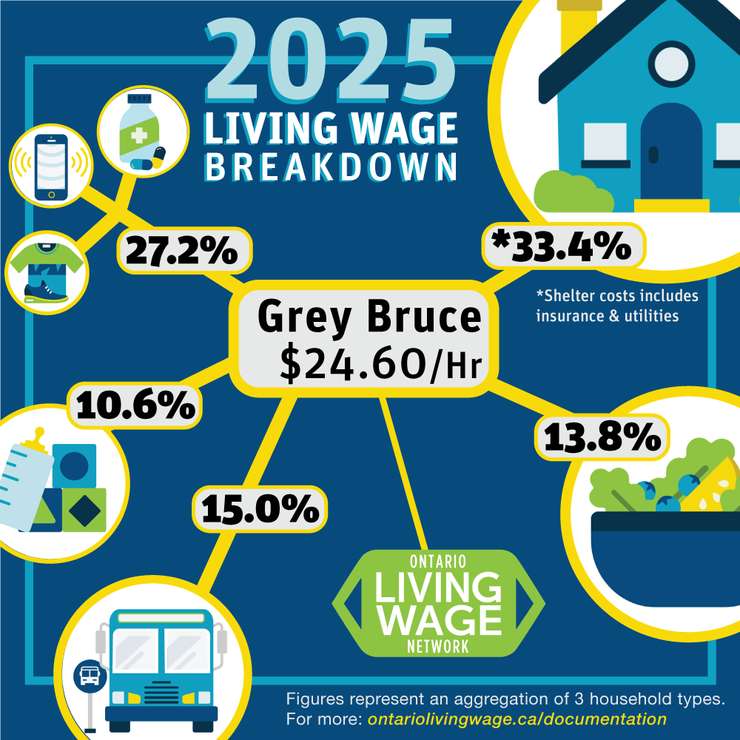United Way Bruce Grey has released its annual living wage report, stating that the living wage in the region has risen 6.7 per cent from last year to sit at $24.60 per hour.
In 2024, the living wage was calculated at $23.05/hour. It was $22.75 in 2023.
Jill Umbach, Co-ordinator of the Bruce Grey Poverty Task Force, says this represents one of the highest increases in the province. She explains the living wage is what a full-time worker in the region needs to make to afford living in an area, and they base it off three different scenarios.
"A single adult and what they need to make. A single parent with two children, and then the third scenario we look at is two parents with two children. Single household earners, obviously need to make more," Umbach pointed out. "So the single adult needs $25.30/hour, the single parent with two children needs $27.75/hour and the two parents with two kids need $23.50/hour with both parents working and making that wage."
Umbach says those three numbers are averaged out to make the living wage number of $24.60/hr.
That comes down to a number of factors, chief among them being housing and transportation challenges. She says it is now a luxury to be able to afford to live where you work.
"In the urban centres they will give a family bus passes and you have the public transit system and people commute to work via public transit. So that's a huge difference in our region," Umbach noted.
Umbach adds the lack of public transit in our area makes it tough for many people to get to work. On top of steep housing costs, including ever-increasing rents, and the lack of dependable transportation, it's getting more difficult to make ends meet.
"That's one of the reasons why we are the second highest increase and highest rate in Ontario as compared to Ottawa and other cities. It's because we do lack that large public transit system that would really go a long way in supporting families," she said.
With respect to employers and the role they play, Umbach says it is critical to have businesses that commit to the living wage numbers not just once.
"What's really critical is that they make a commitment annually to a living wage. So it's not just 'Okay, this year we pay a living wage,' but year-on-year, these are employers that say 'Okay, we'll take a look at that wage change and we will re-commit to it,'" Umbach explained.
More information on living wages can be found by visiting the Ontario Living Wage Network website, and Umbach says that organization works closely with employers to try and emphasize a living wage's importance.
"The Ontario Living Wage Network spends a lot of time and engagement with those employers. We have about 11-12 in our area right now that are living wage employers, and some of them are part of a larger Ontario-wide commitment," said Umbach.
She points to things like businesses with multiple branches, like banks for instance, that have a presence across the province that commit to a living wage for employees.
Also, with more and more people struggling to make ends meet, Umbach says the United Way and many other organizations are seeing sharp rises in people using food banks and community meal programs to eat, and the perception that only people riding the poverty line are accessing those services sadly isn't true anymore.
"We are ringing the alarm bell to say the number of people going to the food banks are increasings and many of those people are working. So it means that people are working jobs that just aren't paying enough to get by day-to-day," she shared.
There are currently over 630 certified Living Wage employers across Ontario, covering more than 860 workplaces, who recognize the benefits of paying fair wages to their employees, according to the United Way Bruce Grey.
"Each year, the Living Wage tells a story about affordability in our communities," said Francesca Dobbyn, Executive Director of United Way Bruce Grey. "A 6.7 per cent increase isn’t just a number, it’s a reflection of the daily struggles families face to stay housed, feed their kids, and keep the lights on. We’re seeing more people working full-time who still can’t make ends meet, and that’s unacceptable. A living wage isn’t a luxury; it’s the foundation for dignity and stability."
The United Way Perth Huron also shared the new living wage information in a release. That organization is echoing the same sentiments shared in Grey and Bruce.
"Making our communities more livable is an ongoing effort," added UWPH Executive Director, Ryan Erb. "Unfortunately, shelter costs continue to be a major driver of the increase to the living wage rate locally, as are the higher costs of transportation in rural communities like ours. To illustrate the difference, if a person has a full-time job paying minimum wage, even with October’s increase workers would be left $245 short every week. That’s an impossible situation. If nobody can afford to live here, how will our communities sustain themselves? We owe it to ourselves to ensure the places we live can thrive, not just survive. A living wage is part of that."
For more information about the living wage, including how businesses can certify, visit perthhuron.unitedway.ca.







